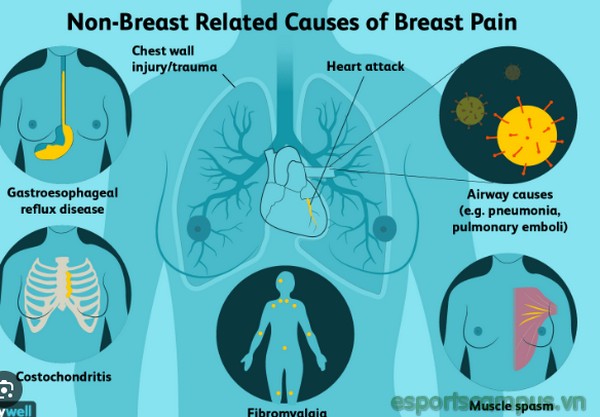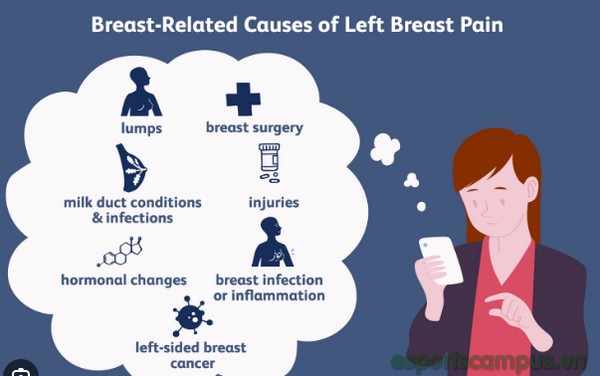Dealing With Stabbing Pain Under Left Breast
Welcome to esportscampus.vn! In this insightful article titled “Dealing With Stabbing Pain Under Left Breast” we delve into a topic that addresses a common yet often perplexing concern. Experiencing stabbing pain beneath the left breast can be distressing, and our aim is to guide you through a comprehensive exploration of its potential causes, diagnostic processes, and effective management strategies. Join us as we navigate through the intricacies of this discomfort, shedding light on the importance of timely medical attention and personalized care. Your well-being is our priority, and we’re here to empower you with knowledge and guidance.

I. Stabbing pain under left breast
Experiencing stabbing pain under the left breast can be an alarming and discomforting sensation that prompts individuals to seek answers. This article delves into the potential causes behind this specific type of pain, highlighting the importance of understanding its origins for proper diagnosis and management.
Understanding the Anatomy: Before delving into the potential causes, it’s important to understand the anatomy of the left chest region. The left breast is situated above the heart and adjacent to vital organs such as the lungs, stomach, and diaphragm. This intricate arrangement contributes to the variety of issues that might lead to stabbing pain in this area.
Possible Causes:
- Cardiac Causes: Stabbing pain under the left breast might originate from cardiac issues. Angina, a condition caused by reduced blood flow to the heart muscle, can lead to chest pain that may radiate to the left side, mimicking stabbing sensations.
- Gastrointestinal Distress: Gastrointestinal problems like gastritis, acid reflux, or peptic ulcers can cause referred pain under the left breast. The close proximity of the stomach and esophagus to this area can result in discomfort that resembles stabbing pain.
- Respiratory Issues: Conditions affecting the lungs, such as pleurisy (inflammation of the lining around the lungs) or pneumonia, might cause sharp pain under the left breast due to shared nerve pathways.
- Musculoskeletal Factors: Strained or injured muscles and ligaments in the chest area can lead to stabbing pain. Conditions like costochondritis, an inflammation of the rib cartilage, can also result in discomfort in this region.
- Psychological Factors: Emotional stress and anxiety can manifest physically as chest pain, including stabbing sensations under the left breast. It’s essential to consider these factors in the diagnostic process.
- Other Causes: Less common causes may include nerve impingements, breast-related issues, or referred pain from other parts of the body.

II. Video Dealing With Stabbing Pain Under Left Breast
III. Possible Causes of Stabbing Pain
Providing a comprehensive overview of the various potential causes that can lead to the sensation of stabbing pain under the left breast. This section is divided into subsections, each discussing a specific category of causes:
- Cardiac-Related Causes Stabbing pain under the left breast can stem from issues related to the heart. Conditions like angina, caused by reduced blood flow to the heart muscle, can result in chest pain that radiates to the left side, giving rise to stabbing sensations.
- Gastrointestinal Distress Gastrointestinal problems such as gastritis, acid reflux, or peptic ulcers can trigger referred pain under the left breast. The close proximity of the stomach and esophagus to this region can cause discomfort resembling stabbing pain.
- Respiratory Issues Disorders affecting the lungs, such as pleurisy (inflammation of the lining around the lungs) or pneumonia, may be responsible for sharp pain under the left breast due to shared nerve pathways.
- Musculoskeletal Factors Strained or injured muscles and ligaments in the chest area can lead to stabbing pain. Conditions like costochondritis, characterized by inflammation of rib cartilage, can also contribute to discomfort in this region.
- Psychological Factors Emotional stress and anxiety can manifest physically as chest pain, including stabbing sensations under the left breast. It’s essential to consider these factors in the diagnostic process.
- Other Factors Warranting Consideration Less common causes include nerve impingements, breast-related issues, or referred pain from other parts of the body. These factors need to be evaluated when investigating the source of stabbing pain.
By understanding the diverse array of potential causes, individuals can better comprehend the complexity of this symptom and seek appropriate medical evaluation to identify the underlying issue accurately.

IV. The Importance of Seeking Medical Evaluation
Emphasizing the significance of seeking medical attention when experiencing stabbing pain. Discussing the potential risks of ignoring the symptom and the benefits of timely diagnosis. Highlighting the role of healthcare professionals in conducting thorough evaluations.
Experiencing stabbing pain under the left breast can be unsettling and concerning. While it’s tempting to brush off such discomfort as temporary or inconsequential, the importance of seeking medical evaluation cannot be overstated. Ignoring or downplaying this symptom can lead to potential complications and hinder the opportunity for timely intervention.
By seeking prompt medical attention, individuals can mitigate the risks associated with undiagnosed underlying causes. Stabbing pain, regardless of its intensity, could be indicative of a serious underlying condition. The potential consequences of overlooking the symptom range from missing out on early treatment options to allowing a manageable issue to escalate into something more severe.
Healthcare professionals play a pivotal role in this process. Their expertise, diagnostic tools, and thorough evaluations are crucial in identifying the root cause of the stabbing pain. Through medical history assessment, physical examination, and possibly additional tests, healthcare providers can offer insights into whether the pain is cardiac-related, gastrointestinal in nature, musculoskeletal, or influenced by psychological factors.
Ultimately, timely medical evaluation not only aids in accurate diagnosis but also ensures appropriate and targeted treatment. Addressing the underlying cause effectively can alleviate discomfort, prevent potential complications, and contribute to an improved quality of life. Therefore, individuals experiencing stabbing pain under the left breast should prioritize their health by seeking the attention of healthcare professionals for a comprehensive assessment.

V. Diagnostic Process and Medical Tests
Detailing the medical evaluation process, including medical history, physical examination, and medical tests. Explaining common diagnostic tests that might be conducted, such as electrocardiogram (ECG), chest X-ray, and endoscopy. Clarifying how these tests support in identifying the underlying root cause of the stabbing pain.
When facing the perplexing symptom of stabbing pain under the left breast, a crucial step towards understanding and resolving the issue is the diagnostic process. Healthcare professionals follow a comprehensive approach to uncover the source of the discomfort, ensuring accurate diagnosis and tailored treatment.
The journey begins with a thorough review of the individual’s medical history. This involves discussions about past medical conditions, family history, medications, and lifestyle factors. This initial step provides valuable context that guides subsequent evaluations.
Physical examinations are a fundamental aspect of the diagnostic process. Through palpation, auscultation, and other examination techniques, healthcare providers can gather vital information about the body’s condition. The specific location, intensity, and any associated symptoms of the stabbing pain can offer valuable clues.
In addition to medical history and physical exams, medical tests play a pivotal role in confirming or ruling out potential causes. Commonly employed tests include the electrocardiogram (ECG) to assess heart function, chest X-rays to visualize the chest cavity, and endoscopy to examine the gastrointestinal tract. These tests provide tangible insights into the inner workings of the body and contribute to an accurate diagnosis.
The electrocardiogram (ECG) records the heart’s electrical activity, helping to detect any abnormalities that might be causing cardiac-related pain. Chest X-rays provide images of the heart, lungs, and surrounding structures, aiding in the identification of respiratory or musculoskeletal issues. Endoscopy allows for direct visualization of the gastrointestinal tract, assisting in the diagnosis of gastrointestinal disorders.
Each of these tests is a valuable tool in the diagnostic arsenal. They empower healthcare professionals to pinpoint the root cause of the stabbing pain, guiding them towards appropriate treatment strategies. Through these meticulous evaluations, individuals can gain clarity about their condition and take proactive steps towards resolution and relief.

VI. Treatment and Management Strategies
Discussing treatment approaches based on the specific underlying causes of the stabbing pain: Cardiac Issues: Lifestyle changes, medications, and medical procedures Stabbing pain associated with cardiac issues necessitates a multifaceted approach. Lifestyle modifications such as adopting a heart-healthy diet, engaging in regular exercise, and managing stress can help improve heart health. Medications might be prescribed to address underlying heart conditions. In some cases, medical procedures like angioplasty or stent placement might be necessary to restore blood flow to the heart.
Gastrointestinal Problems: Dietary modifications and medications For stabbing pain stemming from gastrointestinal distress, dietary adjustments play a crucial role. Avoiding trigger foods, eating smaller, more frequent meals, and staying hydrated can alleviate symptoms. Medications like antacids or proton pump inhibitors might be recommended to reduce acid production and promote healing of the gastrointestinal lining.
Musculoskeletal Issues: Rest, physical therapy, and pain relievers When musculoskeletal factors contribute to stabbing pain, rest is paramount. Physical therapy exercises can help improve posture, strengthen muscles, and alleviate discomfort. Over-the-counter or prescribed pain relievers can provide temporary relief while addressing the root cause.
Psychological Factors: Stress management techniques and counseling Stabbing pain related to psychological factors requires a holistic approach. Stress management techniques such as deep breathing, mindfulness, and meditation can help manage pain perception. Counseling or therapy sessions provide individuals with coping strategies and emotional support to address the psychosomatic aspect of the pain.
Each individual’s treatment plan is tailored to their specific situation and the underlying cause of their stabbing pain. It’s imperative to consult healthcare professionals for guidance, as they can recommend appropriate interventions based on a thorough evaluation. By addressing the root cause and adopting effective management strategies, individuals can strive for relief and an improved quality of life.